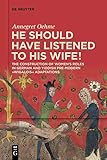«He should have listened to his wife!» : The Construction of Women’s Roles in German and Yiddish Pre-modern 'Wigalois' Adaptations / Annegret Oehme.
Material type: TextPublisher: Berlin ; Boston : De Gruyter, [2020]Copyright date: ©2020Description: 1 online resource (78 p.)Content type:
TextPublisher: Berlin ; Boston : De Gruyter, [2020]Copyright date: ©2020Description: 1 online resource (78 p.)Content type: - 9783110621990
- 9783110678369
- 9783110624403
- Arthurian romances -- History and criticism
- German literature -- Middle High German, 1050-1500 -- History and criticism
- Sex role in literature
- Women in literature
- Yiddish literature -- History and criticism
- Artusroman
- Jüdische Literatur
- Wirnt, von Grafenberg
- LITERARY CRITICISM / European / German
- Arthurian romance
- Jewish literature
- Wirnt von Grafenberg
- 831/.21 23/eng/20230216
- online - DeGruyter
- Issued also in print.
| Item type | Current library | Call number | URL | Status | Notes | Barcode | |
|---|---|---|---|---|---|---|---|
 eBook
eBook
|
Biblioteca "Angelicum" Pont. Univ. S.Tommaso d'Aquino Nuvola online | online - DeGruyter (Browse shelf(Opens below)) | Online access | Not for loan (Accesso limitato) | Accesso per gli utenti autorizzati / Access for authorized users | (dgr)9783110624403 |
Browsing Biblioteca "Angelicum" Pont. Univ. S.Tommaso d'Aquino shelves, Shelving location: Nuvola online Close shelf browser (Hides shelf browser)

|

|

|

|

|

|

|
||
| online - DeGruyter Literatura y política : Nuevas perspectivas teóricas / | online - DeGruyter Die Güte der Gütemaße : Zur Bewertung von Strukturgleichungsmodellen / | online - DeGruyter Das Buch Ezechiel : Komposition, Redaktion und Rezeption / | online - DeGruyter «He should have listened to his wife!» : The Construction of Women’s Roles in German and Yiddish Pre-modern 'Wigalois' Adaptations / | online - DeGruyter Systematisches Fallrepetitorium Verfassungsrecht : Staatsorganisationsrecht, Grundrechte / | online - DeGruyter Figuring It Out : Logic Diagrams / | online - DeGruyter Systematisches Fallrepetitorium Allgemeines Verwaltungsrecht. Band 2, Verwaltungsverfahrensrecht (VwVfG) / |
Frontmatter -- Acknowledgements -- Contents -- 1. Introduction -- 2. Wigalois: Exalting Female Devotion -- 3. Wigoleis: Mother Mary’s Maidens -- 4. Viduvilt: Mothers Seizing Power -- 5. Epilogue -- Bibliography
restricted access online access with authorization star
http://purl.org/coar/access_right/c_16ec
This publication uncovers two previously dismissed pre-modern adaptations of the Middle High German Wigalois (1215) by exploring their different approaches to female agency in comparison with the original Wigalois, the Yiddish Viduvilt (14th ct.) and the German Wigoleis (15th ct.). Traditionally, scholarship often concentrated on the Yiddish text presenting female figures as behaving in a "Jewish manner" or embodying famous Jewish mythical figures such as Lilith (see Achim Jaeger / Robert G. Warnock). Rather than trying to argue for or against a figure’s "Jewishness," I evaluate these interpretations from the perspective of Arthurian Literature by showing that the construction of female agency is at the center of all three adaptations of this important chapter of German-Jewish literature and culture.
Issued also in print.
Mode of access: Internet via World Wide Web.
In English.
Description based on online resource; title from PDF title page (publisher's Web site, viewed 25. Jun 2024)


